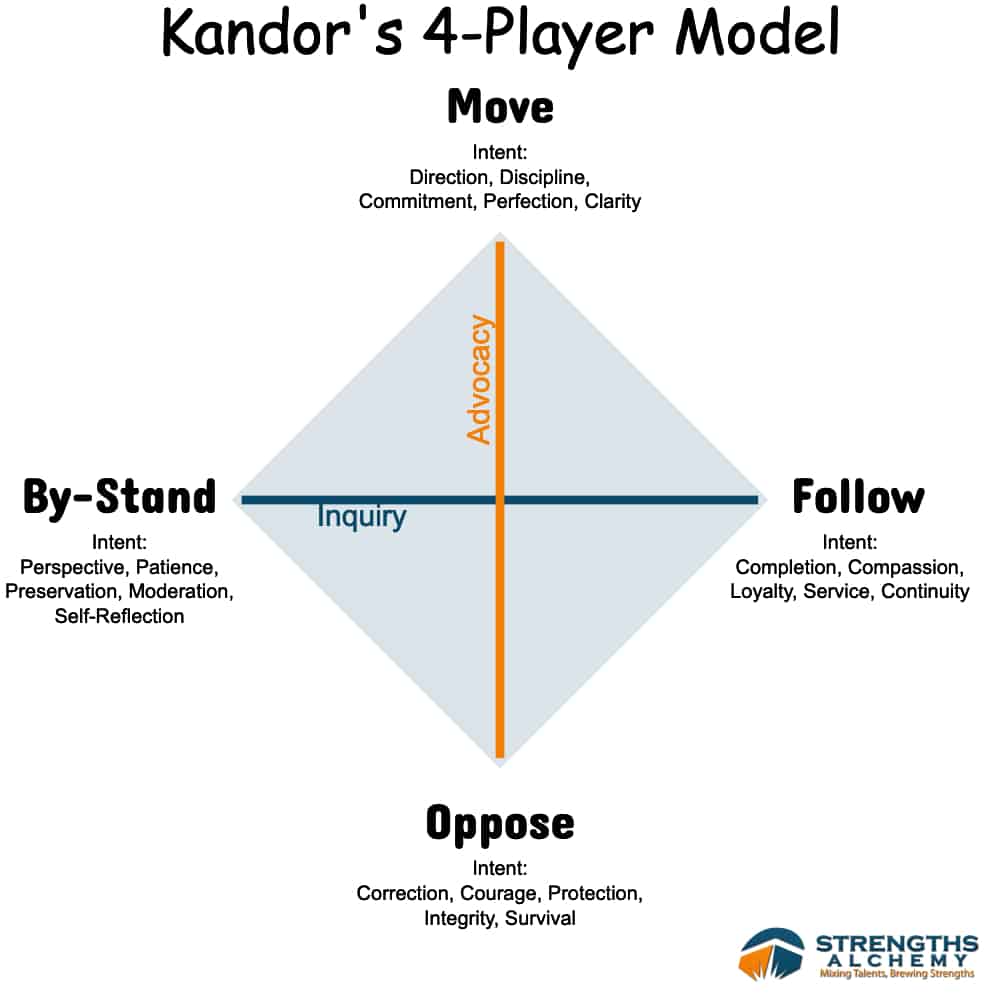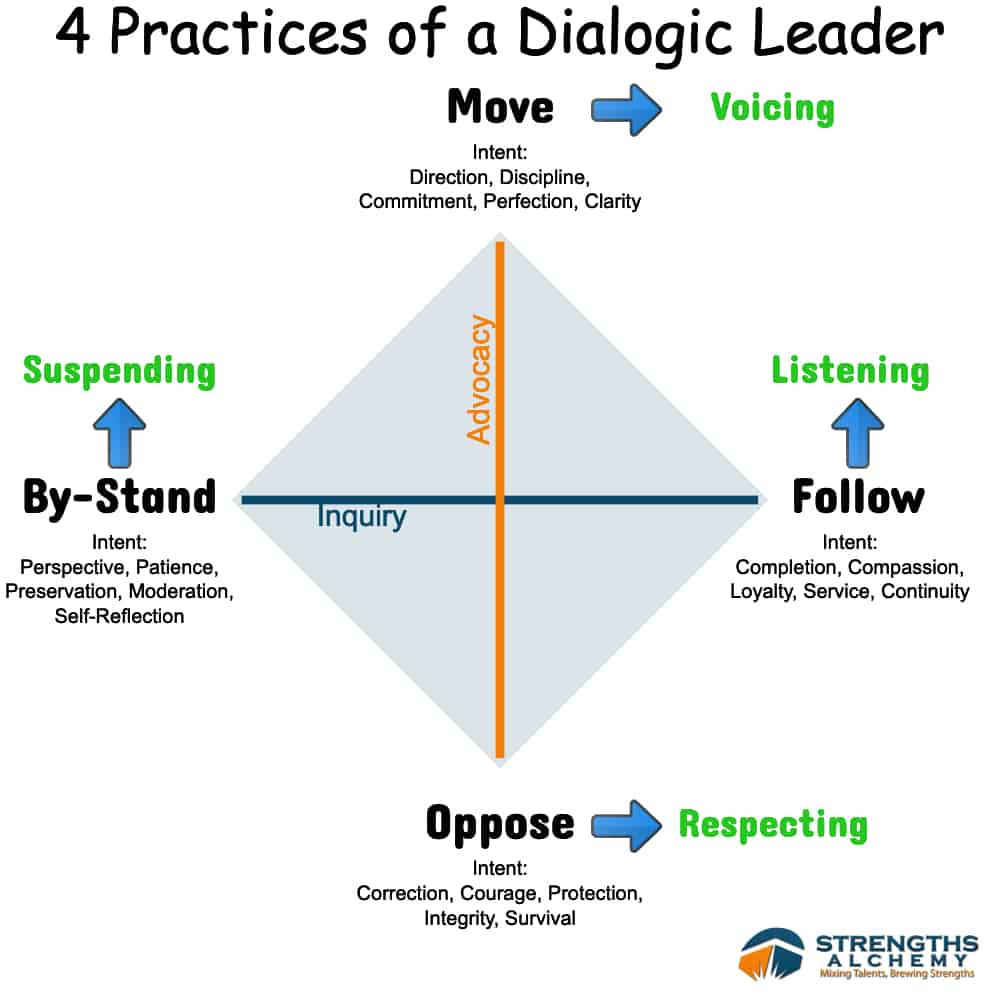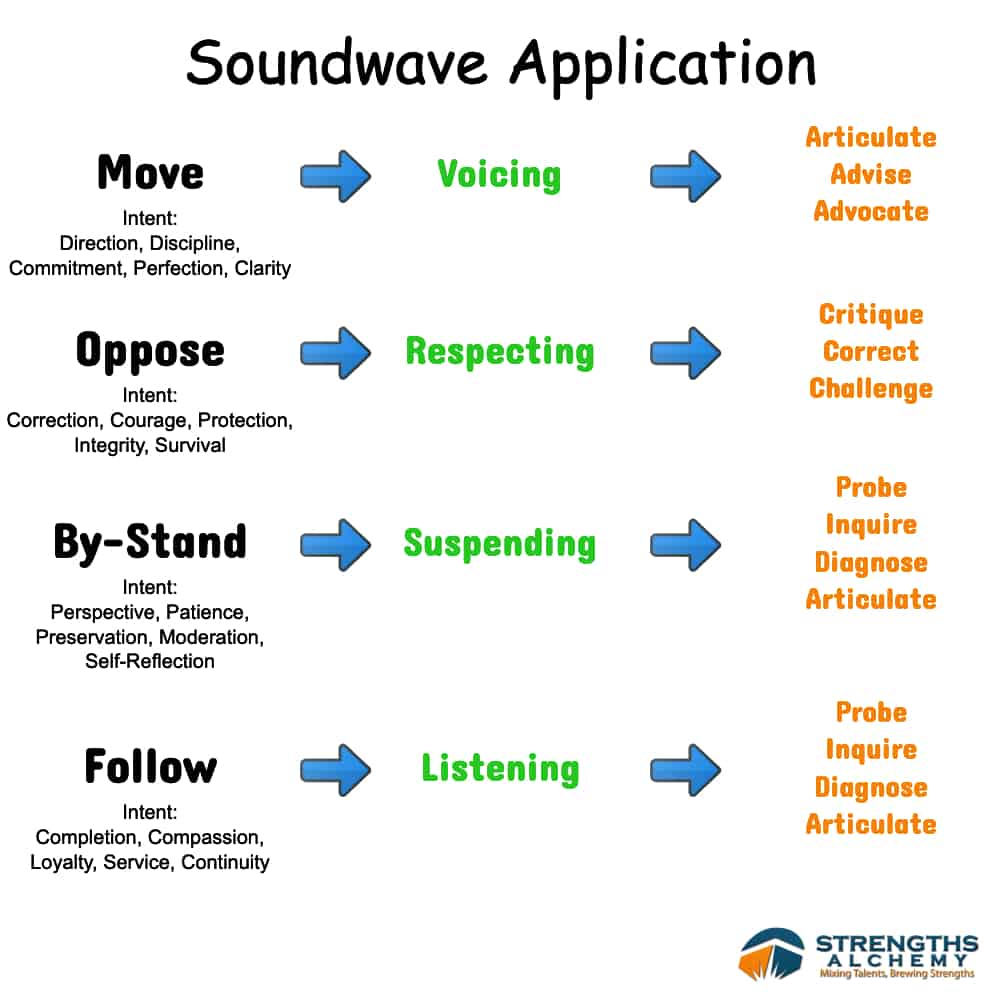
The roots of the word dialogue come from the Greek words dia and logos . Dia means ‘through’; logos translates to ‘word’ or ‘meaning’. In essence, a dialogue is a flow of meaning.
The picture or image that this derivation suggests is of a stream of meaning flowing among and through and between us. This will make possible a flow of meaning in the whole group, out of which may emerge some new understanding. It’s something new, which may not have been in the starting point at all. It’s something creative. And this shared meaning is the ‘glue’ or ‘cement’ that holds people and societies together.
The essence of dialogue is an inquiry that surfaces ideas, perceptions, and understanding that people do not already have.
Why am I talking about dialogue? I’ve recently come across the topic of Dialogic Leadership and the 4-Player Model, and thought that this gels extremely well with the SoundWave Profile, which is about becoming a verbal strategist.
Dialogic Leadership
Firstly, what is Dialogic Leadership?
“Dialogic leadership” is the term to describe a way of leading that consistently uncovers, through conversation, the hidden creative potential in any situation. Four distinct qualities support this process:
The abilities
- to evoke people’s genuine voices,
- to listen deeply,
- to hold space for and respect as legitimate other people’s views, and
- to broaden awareness and perspective.
Put differently, a dialogic leader is balanced, and evokes balance, because he can embody all four of these qualities and can activate them in others.
Personally, I think leaders, managers, coaches and mentors would all benefit from being able to do this well.
4-Player Model of Communication

The 4 Player model of communication is created by David Kantor, a well-known family systems therapist and author of several books. In this model, there are four kinds of conversational actions within a group:
- Move – When someone makes a move they are initiating an action. They carry, at least for the moment, the focus of the conversation
- Follow – Another person listening to this initial proposal might agree and want to support what is being said. This person says so, and symbolically becomes close to the first person. The second person could be said to be following the first.
- Observe – A third person, watching these two agree, may think to herself, There is something not quite right with this picture. She steps in and opposes them, challenging what they are saying or proposing. Symbolically, this third person might stand between the first two.
- By-stand – A fourth person, who has been observing the entire situation, and who has the advantage of having one foot in and one foot out of the circumstance, describes his perspective of what he has seen and heard. This person may propose a way of thinking and seeing that expands everyone’s vision, and could be called a bystander.
All four conversational actions are necessary and important for effective conversations or dialogue. However, individuals tend to have a preference and in some situations may stay stuck in one particular mode, leading to ineffective conversations or dialogue.
The role of the Dialogic Leader is to help the team get unstuck and restore balance in the conversation. William N. Isaacs suggests that there are 4 practices for a Dialogic Leader that corresponds to the 4-Player Model, and enhances the quality of conversations. For more details, please read the article in the references list below, but briefly they are:
- Listening – To understand in order to follow well.
- Respecting – To change the quality of opposing by creating an atmosphere of respect encourages people to look for the sense in what others are saying and thinking.
- Suspending – To by-stand with awareness (and without judgement) that allows us to observe more objectively
- Voicing – To move by speaking with authentic voice

Being able to cultivate these 4 practices within oneself and the team will help to shift the quality of the conversations, and therefore transform the quality of the outcomes.
Introducing the SoundWave Model

SoundWave is a sociometric (as opposed to psychometric) profiling tool looks at the way we use language and at our conversational style, and demonstrates how, when we use talk consciously – with purpose and with imagination – we create powerful relationships.
Under this model, there are 3 verbal styles we can use to communicate: Ask, Tell or Suggest.
Asking is the brilliance of Inquisitiveness.
When we ask well, people think of solutions and possibilities, feel engaged, and act in line with their own thinking.
There are 3 different asking voices – Probe, Inquire and Diagnose.
Telling is the brilliance of Shaping.
When we tell well, people think with clarity, feel respected, and act in line with your expectations.
There are 3 different telling voices – Critique, Correct and Challenge.
Suggesting is the brilliance of Influencing.
When we suggest well, people think broadly, feel involved, and act participatively.
There are 3 different suggesting voices – Articulate, Advise and Advocate.
Each of these 9 voices could either be used skillfully, or unskillfully (i.e. Passive or Accentuated), resulting in a total of 27 different voices.
Click here for more details on the Soundwave Model and the reports available, or watch our eCourse “You Own the Conversation”.
Soundwave Application to Dialogic Leadership and the 4-Player Model

Understanding your Soundwave profile can help to understand your preferred voices, it’s impact on others, and how to adjust it.
The diagram above shows the different voices that may be helpful in the four conversational actions identified in Kantor’s 4-Player Model. If you find yourself challenged in any one of the four conversational actions, a deeper look into how skilled you are in the corresponding voices may give you insights on how to get better.
Let’s take “Oppose” as an example. The intent of that conversational action is for correction, protection, and to preserve integrity. To do it well, one needs to create an atmosphere of respect, which also induces an environment of psychological safety. Otherwise, you risk triggering the fight or flight response from the other party. When you come from a place of mutual respect, you can explore which voices you could use to “oppose”:
- Critique – To lay out the pros and cons, dissect the options rigorously to make a better decision
- Correct – To bring about adherence to an agreement, standard, or policy.
- Challenge – To disrupt current thinking, and bring about a new way of looking at or doing things.
As you can see, understanding the four-player model, the four practices of a Dialogic leader, and your personal Soundwave profile can help you to increase your effectiveness as a leader, and the quality of your conversations in general.
Click here for more information on the Soundwave Profile.
References:
